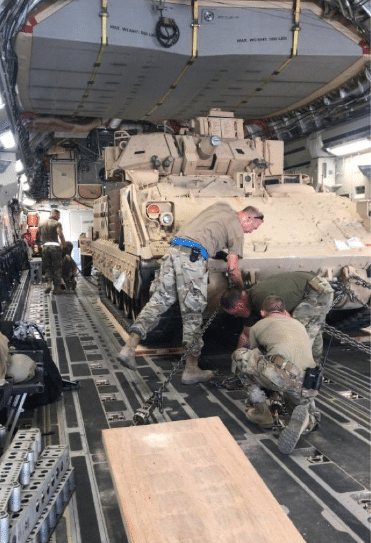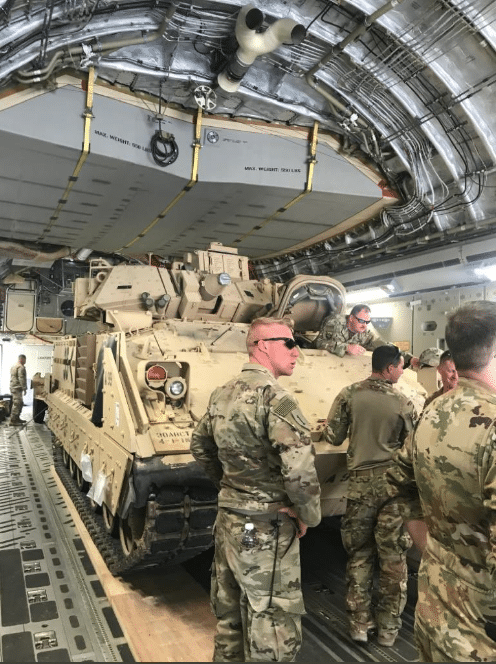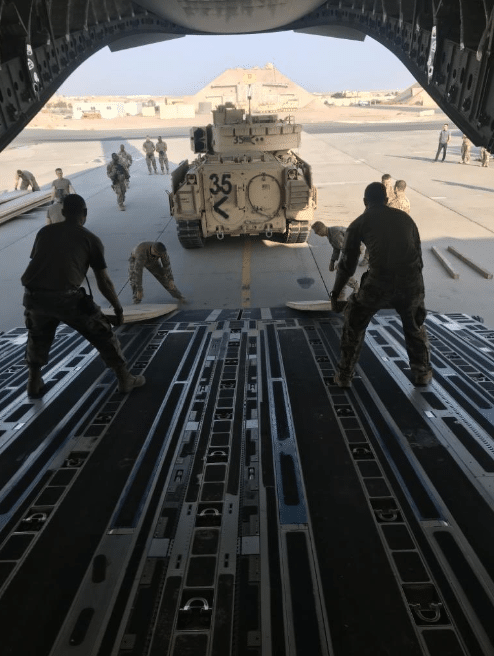Despite President Donald Trump’s decision for a complete removal of U.S. troops from Syria, those troops are moving back into the country amid dual concerns of ISIS may capture vulnerable oil fields.
A U.S. military spokesman announced the arrival of several armored units in the eastern Syrian region of Deir ez Zor. According to Fox News, the primary goal of the deployment is to protect oil fields vulnerable to ISIS attacks.

US Army troops in the NC National Guard’s 4-118th Infantry Regiment, 30th Armored Brigade Combat Team, and SC National Guard’s 218th Maneuver Enhancement Brigade, bring M2A2 Bradley Fighting Vehicles to support an Operation Inherent Resolve mission in in Deir ez Zor, Syria against ISIS (U.S. Army photo / Released)
In his tweet, Operation Inherent Resolve Spokesman Col. Myles B. Caggins III provided pictures of troops loading M2A2 Bradley Infantry Fighting Vehicles for deployment.

US Army troops in the NC National Guard’s 4-118th Infantry Regiment, 30th Armored Brigade Combat Team, and SC National Guard’s 218th Maneuver Enhancement Brigade, bring M2A2 Bradley Fighting Vehicles to support an Operation Inherent Resolve mission in in Deir ez Zor, Syria against ISIS (U.S. Army photo / Released)
The Army National Guard’s 30th Armored Brigade Combat Team, known as “Old Hickory,” and the 4-118th Infantry Regiment were part of the deployment to Syria.
The new deployment reportedly brings around 500 National Guardsmen to the counter-effort against ISIS.

US Army troops in the NC National Guard’s 4-118th Infantry Regiment, 30th Armored Brigade Combat Team, and SC National Guard’s 218th Maneuver Enhancement Brigade, bring M2A2 Bradley Fighting Vehicles to support an Operation Inherent Resolve mission in in Deir ez Zor, Syria against ISIS (U.S. Army photo / Released)
Another tweet citing Caggins said the operation’s goal was to deny ISIS a potential revenue stream.
@OIRSpox: “We are repositioning @CJTFOIR forces to Deir ez Zor Syria to continue partnering w/ #SDF to defeat ISIS remnants, protect critical infrastructure, & deny ISIS access to revenue sources. @30thabct mechanized forces provide infantry, maneuver, and firepower.”#DefeatDaesh https://t.co/n7nzROONGb
— Special Ops Joint Task Force-OIR (Iraq/Syria) (@SOJTFOIR) October 31, 2019
The deploying units reportedly practiced with M1A1 Abrams tanks during a pre-deployment training, but it was not clear if those tanks would also be deployed alongside the Bradley armored vehicles.
Though Trump did say last week that Turkey had ended a controversial military operation along the Turkish-Syrian border and said U.S. troops could return home, he did also acknowledge some troops would stay behind to guard the Syrian oil fields.
“A small number of U.S. troops will remain in the area where they have the oil,” Trump said at the time. “We’re going to be protecting it, and we’ll be deciding what we’re going to do with it in the future.”
Despite the new deployment and Trump’s prior assurances of a Turkish ceasefire that had threatened U.S.-allied Kurds, those same Kurds have raised concerns of continued Turkish aggression.
The Kurdish forces had been a critical component of U.S. operations against ISIS in Syria. They also assisted in the defense of those vulnerable oil fields, including during one incident in February of 2018 when Russian-backed mercenaries and Syrian forces began an attack on the oil fields.
The deployment of new U.S. troops follows other recent deployments to the Middle East, even as Trump has called for an end to “endless wars” in the long-troubled region. On Oct. 11, the Pentagon approved the deployment of 1,800 more troops and two new fighter squadrons to nearby Saudi Arabia.



